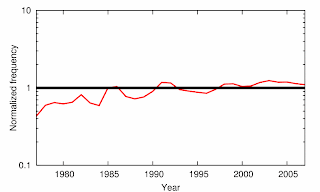Computer science is a fast-changing field of research. Can we track some of its changes in the past? To answer this or any other question, experimental computer science researchers have essentially three options:
- Write a program.
- Search the Internet.
- Write a program that searches the Internet.

Let me say now, in case it becomes unclear later, that all the data presented here is actually derived from the ACM's database; it is not made up. (As for the interpretation of the data, well, ...) Moving on, we can plot a couple other terms, which and that:

The naive reader will conclude that conjunctions went out of fashion in the mid 80's, and came back after the dot com crash. However, the inappropriately perspicacious reader realizes that this conclusion is subtly flawed, because the word "that" might be a pronoun, adjective, or adverb: not just a conjunction. Fortunately the astute reader realizes we can look at relative instead of absolute frequencies to help clean up the data set.
The next group of figures are normalized by the term performance. For example, the blue line in the first plot below shows freq(mobile) / freq(performance).
| Click on the image below for a larger version. |

|
Now some "matchups", where x v. y = freq(x) / freq(y). Click on an image to enlarge.
| distributed v. centralized |  |
| flat v. hierarchical |  |
| Berkeley v. Stanford |  |
| Us v. Them |  |
They're winning, but we're gaining on Them.
Now our final, and perhaps most important, plot.
| Good v. Evil |  |
While computer science is solidly on the side of good, several abstracts in this search were disturbingly megalomaniacal, such as J. R. Landry's "Can computing professionals be the unintentional architects of evil information systems?", in ACM SIGMIS-CPR, 2008. The author "discusses how the technical rational paradigm supports the creation of systems that embody administrative evil" and aims to "determine if information systems can harm or be evil, the frequency of harm, and response to harm by designers and users."
We can be thankful that according to its abstract, the paper is only "a research-in-progress".
This post was originally an Outrageous Opinion at SIGCOMM'08. Here's a PDF of the original presentation.



